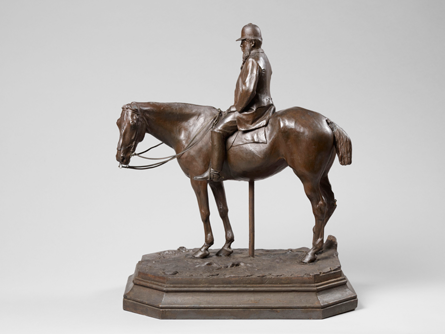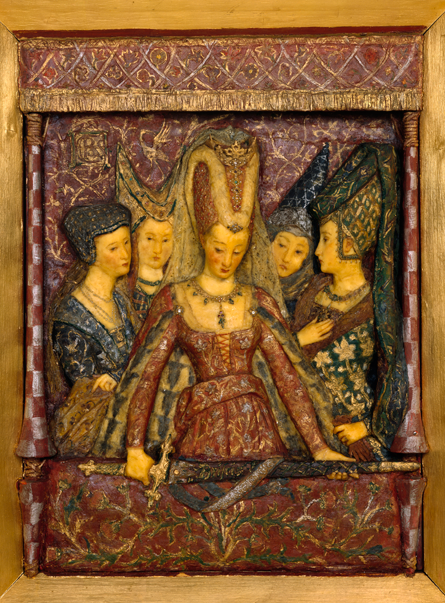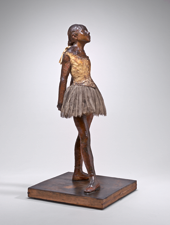The wax figure’s greater sin, for some critics, was its use of ignoble materials — especially to represent one of Paris’ controversial social types — in large-scale sculpture for exhibition. These mundane elements downgraded such works from high art to the realm of popular waxworks and anatomical models. Yet everyday materials were often used to provide a “real” representation in studio or presentation models, wax portraiture, and small-scale equestrian work in the Salon, such as Joseph Cuvelier’s equestrian portrait of his patron M. Baude, shown in 1869 (fig. 1). One critic saw Little Dancer as a presentation model, applauding its apparently imminent execution in nobler materials.[9]
Little Dancer Aged Fourteen
Technical Notes: Internal Construction
Technical Notes: Exterior Construction
Study in the Nude of Little Dancer Aged Fourteen (Nude Little Dancer)
Fourth Position Front, on the Left Leg
Formal Context
In its “realism” of subject, handling, and materials, nineteenth-century opponents accused Little Dancer of not being sculpture, at least that transcendent sort that befitted the art museum; rather, they relegated it to science museums, popular waxworks, and the commercial world of dress mannequins and dolls. Advocates such as Huysmans, however, embraced it fully for overthrowing the prevalent conventions of high art.[1] Yet the sculpture can be seen to adapt, in an unprecedented form, some widely accepted artistic principles, establishing its kinship with other nineteenth-century sculpture that many upheld as positive paradigms. As with Degas’s paintings, some of the wax’s qualities even seem aligned with conservative sculptural views. Working with the problematic human figure, its subtle standing pose, form-fitting costume, and quiet facial expression — all considered criteria of the ancient ideal — can be seen as reconciling the decades-old tension between several poles: iconic stillness (the ideal standard) and movement (the modern); psychological immediacy and transcendent distance; timelessness and historical or natural specificity; formal simplicity and active, detailed surfaces; and smoothly “finished” surfaces and restless ones, whether visibly worked or naturalistic.[2] Such choices relate Degas’s wax to a handful of highly diverse figures that were applauded as “modern.”[3] Eschewing the extreme or complex movement of his smaller work and of other “modern” sculpture, such as Francisque-Joseph Duret’s Neapolitan Fisherboy Dancing the Tarantella (Memory of Naples) (c. 1830 – 1832, life-sized bronze, Musée du Louvre, Paris, serial statuettes), Little Dancer’s subdued stance and face are powerfully alive.
Traditions aside, as a “scientific” rendering of a problematic social type (whether as art or as medical or anthropological specimen), Degas’s figure anticipates the controversial — and vastly more dramatic — forms of realist sculpture representing Paleolithic and modern “primitive” hunters, commissioned by the state in the 1880s from Emmanuel Fremiet and Paul Richer for the Jardin des Plantes, Paris.[4] Its modern clothing was not the issue, though nudity still dominated large-scale sculpture. Portrait and genre sculpture throughout the century had featured fashions so intricately rendered that the classical norm of the timeless, revealed body was often set aside.[5] Polychromy and mixed materials were increasingly common, despite ongoing resistance from critics who advocated the idealist single color in a traditional “finished” sculptural medium (white marble or patinated bronze), even with the massive evidence of polychromy and precious materials on classical Greek marbles.[6] Little Dancer, in fact, appeared within a surge in polychromy that crested soon thereafter.[7] Most polychrome sculpture of this period featured materials traditional to the fine or decorative arts,[8] combined or applied in startling new ways, asserting a sumptuous “aesthetic” presence for sculpture that seems alien to Little Dancer.

Fig. 1: Joseph Cuvelier, Equestrian Portrait of M. Baude, c. 1869, wax and mixed media. Palais des Beaux-Arts, Lille. Photo © RMN-Grand Palais / Art Resource, NY. Photographer: Thierry Olivier

Fig. 2: Henri Cos, Prix du Tournai, 1873, polychrome wax encrusted with stones and pearls. Musée d’Orsay, Paris. Photo © RMN-Grand Palais / Art Resource, NY. Photographer: G. Blot / C. Jean
Little Dancer was thus not unique as a wax exhibited in its definitive state; it was immediately preceded by several in the Salons of the 1870s: two neo-medieval works by Henri Cros (fig. 2) and Jean Désiré Ringel d’Illzach’s life-sized nude, Le Demi Monde (The Demimonde, destroyed) in 1879.[10]
For both Huysmans and de Villars, Little Dancer’s format, as a nearly life-sized freestanding figure, and materials, particularly the wax and “real” dance attire, fix it in the here and now more than even its subject and handling. Soft, colored wax, claims Huysmans, captures the subtleties of modern life that escape marble. For the critic, the sculptor Émile Chatrousse’s “modern” Parisienne (1876, plaster, Musée du Petit Palais, Paris) is a telling failure in these terms. The icy monochromatic stoniness of its white marble, he argues, cannot render the “elegance of our clothing today, the softness of bodies firmed by corset stays . . . the rebellious note that Parisians’ physiognomies take with their frizzy dog-like tresses spilling under those little hats.”[11] Degas, Huysmans contends, took Cros’ medievalism and Ringel’s ahistorical work in wax in a new direction.[12]
Perhaps the most famous precedent for Little Dancer, mentioned by Huysmans, is the polychrome sculpture of Spain that, though mostly of wood or terra-cotta, often includes real hair, fabric, and accessories. Huysmans feels Degas’s figure updates a type: “In taking up the method of the old Spanish masters, M. Degas has made it entirely unique, modern, by the originality of his talent.”[13] For de Villars, however, the same traits link Little Dancer to France’s living popular traditions. The sculpture even fulfills her dream of a “modern and powerful” work that utilizes the “naïve and charming” procedures of the dressed and jeweled colored-wood virgins and saints in France’s village churches.[14] For both critics, Little Dancer incorporates the essence of lived experience — the people’s ritual life — within a compelling sculpture for their time.
Implicit in many comments was the belief that Degas’s wax figure had further destabilized the famously volatile threshold between life and art, an important area of debate about realism and idealism in sculpture. For the idealist Charles Blanc, the lifelikeness of wax figures collapses shockingly into artifice and death at close range, making this type of sculpture the most macabre proof of the limits of illusionism in three-dimensional art.[15]
Little Dancer’s religious resonances, even if only to parody the effigy type for secular purposes, are significant, in part because they stem from the peculiar qualities of wax.[16] Since antiquity wax, as a malleable, notoriously lifelike medium, was a vital element in the dynamics of religious and funerary effigies. Wax’s seemingly supernatural power to stand in for the absent original played an important part in effigy magic, a loaded role for the resulting simulacrum throughout the centuries.[17] Such a magical dimension, which appealed to symbolists and later surrealists, was anathema to traditional historical method and idealist aesthetics, as the foremost historian of wax sculpture of Degas’s time, Julius von Schlosser, maintains, giving rise to much of the critical hostility.[18] Often noted in the bronzes but even more remarkable in the wax, Little Dancer evokes a similar elusive presence, a “thereness” that not all realist sculpture imparts. For Claretie, that quality makes its naturalism troubling and strangely compelling rather than offensive.[19]
Thus, Little Dancer’s combined elements made it a modern artistic paradigm for certain critics of 1881: for Mantz, the artist’s longed-for “ideal of ugliness [un idéal de laideur] fulfilled”; for de Villars, a future museum treasure that today’s public did not understand; for Ephrussi, an admirable, if difficult modern work because it is not the graceful Greek muse Terpsichore; and for Huysmans, “the only truly modern effort I know in sculpture.”[20]
Notes
1. Joris-Karl Huysmans, "L'Exposition des indépendants en 1881," L'Art Moderne, 225–227 (Paris, 1883), 227, echoed by Libby Tannenbaum, "Degas: Illustrious and Unknown," Art News 65, no. 9 (January 1967): 53.
2. Suzanne G. Lindsay, "Western Figurative Sculpture: Foundations and Functions," in The National Sculpture Society Celebrates the Figure, exh. cat. (New York, 1987), 14 – 18.
3. For instance, Paul Dubois’s Fifteenth-Century Florentine Singer (1865, silvered bronze, Musée d’Orsay, Paris) and Gustave Courbet’s Boy Fishing for Chub (1873 – 1877, bronze, outdoor monument, Ornans, France).
4. Philippe Durey, "Le Réalisme," in La Sculpture française au XIXe siècle, exh. cat. (Paris, 1986). For a study of contemporaneous debates surrounding art about human prehistory, see Martha Lucy, "Cormon's Cain and the Problem of the Prehistoric Body," Oxford Art Journal 25, no. 2 (February 2002).
5. See Lindsay, in Ruth Butler and Suzanne Glover Lindsay, European Sculpture of the Nineteenth Century, The Collections of the National Gallery of Art Systematic Catalogue, (Washington, DC, 2000), 216.
6. Antoinette Le Normand-Romain and Jean-Luc Olivié, "La Polychromie," in La Sculpture française au XIXe siècle, exh. cat. (Paris, 1986); Andreas Blühm et al., The Colour of Sculpture, 1840–1910, exh. cat. (Amsterdam, 1996); Laure de Margerie and Édouard Papet, Charles Cordier, 1827–1905: L'Autre et l'ailleurs, exh. cat. (Paris, 2004).
7. Blühm et al., Colour of Sculpture.
8. June Hargrove, "Painter-Sculptors and Polychromy in the Evolution of Modernism," in Blühm et al., Colour of Sculpture, 104 – 105; Andreas Blühm, in ibid., cat. 75, repro.
9. Paul de Charry, "Les Indépendants," Le Pays, April 22, 1881.
10. Huysmans, "L'Exposition," 228 – 229; Jean-Luc Olivié, France Drilhon, Sylvie Colinart, and Anne Tassery-Lahmi, “Henri Cros,” in Jean-René Gaborit and Jack Ligot, eds., Sculptures en cire de l'ancienne Egypte à l'art abstrait, Notes et documents des musées de France (Paris, 1987), 213 – 215; June Hargrove, "Little Fourteen-Year-Old Dancer: Madonna of the Third Republic?" in Horizons: Essays on Art and Art Research, ed. Hans-Jörg Heusser (Zurich, 2001), 147, fig. 2.
11. Huysmans, "L'Exposition," 228: “Cette matière monochrome et glacée, incapable de rendre les élégances des vêtements de nos jours, les mollesses du corps raffermies par les buscs . . . le ton mutin que prennent des physionomies de Parisiennes avec des cheveux à la chien pleuvant sous ces petites toques.” For a differing account of Huysmans’ review of sculpture at this exhibition, see Ward-Jackson 1996.
12. Ibid., 228 – 229.
13. Ibid., 226: “Tout en reprenant la méthode des vieux maîtres espagnols, M. Degas l’a immédiatement faite toute particulière, toute moderne, par l’originalité de son talent.” Though Huysmans may have not meant that Spanish sculpture directly inspired Little Dancer, there is little evidence of Degas’s interest in or knowledge of Spanish polychrome sculpture even after his 1889 trip to Spain. Theodore Reff, Degas: The Artist's Mind (New York, 1976), 246, also suggests eighteenth-century Neapolitan painted terra-cotta Nativity figures as precedents. For examples, see Marisa Piccoli Catello, Il Presepe napoletano (Naples, 1990).
14. Nina de Villars, "Variétés: Exposition des artistes indépendants," Le Courrier du Soir, April 23, 1881, 2.
15. Charles Blanc, Grammaire des arts du dessin: Architecture, sculpture, peinture, 2nd ed. (Paris, 1870), 464.
16. Hargrove, "Little Fourteen-Year-Old Dancer," especially 150.
17. Jack Ligot, “Preface,” in Gaborit and Ligot, Sculptures en cire de l'ancienne Egypte, 7 – 8; Jean-Louis Hellouin de Cenival, “La Cire dans l’ancienne Egypte,” in ibid., 84 – 91. The classic analysis of effigy magic is Ernst Kris and Otoo Kurz, "The Artist as Magician," in Legend Myth, and Magic in the Image of the Artist: A Historical Experiment, trans. Alastair Laing, rev. Lottie M. Newman (New Haven, 1979), especially 71 – 84, which emphasizes the artist’s power.
18. Julius von Schlosser, Histoire du portrait en cire, trans. Édouard Pommier (Paris, 1997).
19. Jules Claretie, "La Vie à Paris: Les Artistes indépendants," in La Vie à Paris: 1881 (Paris, 1881), 151.
20. Paul Mantz, "Exposition des oeuvres des artistes indépendants," Le Temps, April 23, 1881; de Villars, "Variétés"; Charles Ephrussi, "Exposition des artistes indépendants," La Chronique des Arts et de la Curiosité, April 16, 1881, 126; Huysmans, "L'Exposition," 227: “cette statuette est la seule tentative vraiment moderne que je connaisse, dans la sculpture.”
